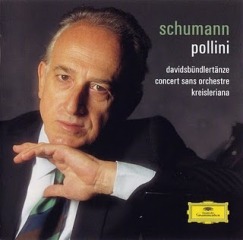Schumann - Davidsbündlertänze • Concert sans Orchestre (2001)
Schumann - Davidsbündlertänze • Concert sans Orchestre (2001)

01. Davidsbündlertänze 1: Lebhaft [0:01:28.63] 02. Davidsbündlertänze 2: Innig [0:01:07.45] 03. Davidsbündlertänze 3: Etwas hahnbüchen [0:01:21.30] 04. Davidsbündlertänze 4: Ungeduldig [0:00:46.32] 05. Davidsbündlertänze 5: Einfach [0:01:26.38] 06. Davidsbündlertänze 6: Sehr rasch und in sich hinein [0:01:52.15] 07. Davidsbündlertänze 7: Nicht schnell und mit äußerst starker Empfindung [0:03:44.42] 08. Davidsbündlertänze 8: Frisch [0:00:40.06] 09. Davidsbündlertänze 9: Notes equal 126 [0:01:24.55] 10. Davidsbündlertänze 10: Balladenmässig, sehr rasch [0:01:19.34] 11. Davidsbündlertänze 11: Einfach [0:01:05.22] 12. Davidsbündlertänze 12: Mit Humor [0:00:37.36] 13. Davidsbündlertänze 13: Wild und lustig [0:03:00.70] 14. Davidsbündlertänze 14: Zart und singend [0:02:03.22] 15. Davidsbündlertänze 15: Frisch [0:01:35.15] 16. Davidsbündlertänze 16: Mit gutem Humor [0:01:36.64] 17. Davidsbündlertänze 17: Wie aus der Ferne [0:03:08.41] 18. Davidsbündlertänze 18: Nicht schnell [0:01:57.45] 19. Concert sans orchestre 1 Allegro brillante [0:07:47.00] 20. Concert sans orchestre 2 Quasi Variazioni: Andantino de Clara Wieck [0:07:05.50] 21. Concert sans orchestre 3 Prestissimo possibile [0:06:52.25] Maurizio Pollini – piano
For some reason, DG has chosen to repackage Maurizio Pollini's two most recent Schumann discs as a single two-disc set. Who can understand the ways of record companies? But whatever the motivation may be, it is good to have these performances all available in one place. While Pollini's Schumann is not to everyone's taste -- some find his virtuoso playing too cool and his bracing interpretations too intellectual -- for those who revere Pollini, his Schumann is a tonic after nearly two centuries of sloppy and sentimental performance practice. Pollini's Davidsbündlertänze may not be as poetic as Arrau's and his Kreisleriana may not be as fantastic as Argerich's, but he finds meanings and significances in the works that no one ever has before. Pollini's Concert sans orchestre and Allegro in B minor are second to none in technical panache and interpretive aplomb. And Pollini's Gesäng der Frühe is deeply soulful, profoundly lyrical, and exceedingly translucent. DG's piano sound is as real as playing the piano. ---James Leonard, Rovi
Now, almost unbelievably, in his 60th year, Maurizio Pollini brings as much temperament and intensity to these two wholly Clara-inspired works as if Schumann's youthful heart was his own. Anyone encountering him here tor the first time might find it hard to believe that in former days his playing was often criticised as too objective, too impersonal. In the Davidsbündlertänze I have rarely heard stronger contrasts between Eusebius's aching, idyllic dreams and Florestan's fiery protests (Schumann's two fictitious selves to whom he openly attributed the composition of the work when it first appeared), with a strong note of petulance, even anger, in the latter in response to rejection by Clara's unyielding father.
Schumann devotees will immediately recognise what follows as part of the work that eventually emerged in the early 1850s as his Piano Sonata No 3 in F minor. Pollini has chosen to remind us that though originally conceived as an expansive five-movement sonata, Schumann's publisher advised him to introduce it to the world in 1836 with its two Scherzos omitted under the curious title of Concert sans orchestre.
Predating the Davidsbündlertänze by a year, it grew from even darker days of despair during enforced separation from his beloved, despair which explodes in a tumult of notes that in incompetent hands can sound perfunctorily repetitive. But even in the lengthy prestissimo possible finale, Pollini, with his transcendental agility and magical transparency of texture, holds you spellbound to the very end. Never is there a moment's doubt that so very much in the work stems from Clara's falling F minor motto (always as symbolic as a ring for both young lovers) which generated the here so deeply laden variations of the central Andantino. I found nothing to question in the quality of DG's recording. -- Joan Chissell, Gramophone
download: uploaded yandex 4shared mediafire solidfiles mega zalivalka filecloudio anonfiles oboom
Last Updated (Friday, 02 May 2014 12:28)
